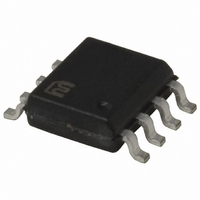MIC5020YM Micrel Inc, MIC5020YM Datasheet - Page 6

MIC5020YM
Manufacturer Part Number
MIC5020YM
Description
IC DRIVER MOSF LO SIDE HS 8-SOIC
Manufacturer
Micrel Inc
Datasheet
1.MIC5020YM_TR.pdf
(8 pages)
Specifications of MIC5020YM
Configuration
Low-Side
Input Type
Non-Inverting
Delay Time
400ns
Number Of Configurations
1
Number Of Outputs
1
Voltage - Supply
11 V ~ 50 V
Operating Temperature
-40°C ~ 85°C
Mounting Type
Surface Mount
Package / Case
8-SOIC (3.9mm Width)
Device Type
Low Side
Module Configuration
Low Side
Input Delay
400ns
Output Delay
900ns
Supply Voltage Range
11V To 50V
Driver Case Style
SOIC
No. Of Pins
8
Number Of Drivers
1
Driver Configuration
Non-Inverting
Driver Type
Low Side
Input Logic Level
TTL
Rise Time
1500ns
Fall Time
1500ns
Frequency (max)
150MHz
Operating Supply Voltage (max)
50V
Operating Supply Voltage (min)
11V
Turn Off Delay Time
1.5ps
Turn On Delay Time (max)
800ps
Operating Temp Range
-40C to 85C
Operating Temperature Classification
Industrial
Mounting
Surface Mount
Pin Count
8
Package Type
SOIC
Lead Free Status / RoHS Status
Lead free / RoHS Compliant
Current - Peak
-
High Side Voltage - Max (bootstrap)
-
Lead Free Status / RoHS Status
Compliant, Lead free / RoHS Compliant
Other names
576-1818-5
MIC5020YM
MIC5020YM
Available stocks
Company
Part Number
Manufacturer
Quantity
Price
Part Number:
MIC5020YM
Manufacturer:
MIC
Quantity:
20 000
MIC5020
Lamp Driver Application
Incandescent lamps have a high inrush current (low resis-
tance) when turned on. The MIC5020 can perform a “soft
start” by pulsing the MOSFET (overcurrent condition) until
the filament is warm enough for its current to decrease (re-
sistance increases). The sense resistor is selected so the
voltage across the sense resistor drops below the sense
threshold (50mV) as the filament becomes warm.
MOSFET is no longer pulsed to limit current and the lamp
turns completely on.
A lamp may not fully turn on if the filament does not heat up
adequately. Changing the duty cycle, sense resistor, or both to
match the filament characteristics can correct the problem.
Soft start can be demonstrated using a #1157 dual-filament
automotive lamp. The value of R
for soft start of the higher-resistance filament (measures
approx. 2.1Ω cold or 21Ω hot).
Solenoid Driver Application
The MIC5020 can be directly powered by the control voltage
supply in typical 11Vdc through 50Vdc control applications.
Current sensing has been omitted as an example.
A diode across the load protects the MOSFET from the volt-
age spike generated by the inductive load upon MOSFET
turn off. The peak forward current rating of the diode should
be greater than the load current.
MIC5020
TTL Input
TTL Input
(0V/5V)
10µF
10µF
demo circuit. See text.
+11V to +50V
“( )” values apply to
Figure 1. Lamp Driver with
Figure 2. Solenoid Driver,
Without Current Sensing
1
2
3
4
Current Sensing
1
2
3
4
V
Input
Fault
C
V
Input
Fault
C
DD
T
DD
T
MIC5020
MIC5020
Sense-
Sense+
Sense-
Sense+
Gate
Gate
Gnd
Gnd
Solenoid
S
8
7
6
5
8
7
6
5
shown in figure 1 allows
V+
V+
N-Channel
Power MOSFET
(IRF540)
N-Channel
Power MOSFET
R
(0.041Ω)
(+11V to +12V)
S E N S E
Incandescent
Lamp (#1157)
Diode
The
6
Current Sensing MOSFET Application
A current sensing MOSFET allows current sensing without
adding additional resistance to the power switching circuit.
A current sensing MOSFET has two source connections: a
“power source” for power switching and a “current source”
for current sensing. The current from the current source is
approximately proportional to the current through the power
source, but much smaller. A current sensing ratio (I
I
The MOSFET current source is used to develop a voltage
across a sense resistor. This voltage is monitored by the
MIC5020 (
current condition.
The value of the sense resistor can be estimated with:
where:
The drain to source voltage under different fault conditions
affects the behavior of the MOSFET current source; that is, the
current source will respond differently to a slight over-current
condition (V
V
Adjustment of the sense resistor value by experiment starting
from the above formula will provide the quickest selection
of R
Refer to manufacture’s data sheets and application notes
for detailed information on current sensing MOSFET char-
acteristics.
Figure 3 includes values which can be used to demonstrate
circuit operation. The IRCZ24 MOSFET has a typical sense
ratio of 780 and a R
load resistor will cause inductive spikes which should be
suppressed using a diode (using the same configuration as
figure 2).
SENSE
DS(ON)
R
R
V
r = manufacturer’s current sense ratio: (I
R
I
+11V to +50V
LOAD
TRIP
SENSE
SENSE
DS(ON)
SENSE
TTL Input
Figure 3. Using a Current Sensing MOSFET
(+13.2V)
) is provided by the MOSFET manufacturer.
(0V/5V)
= 50mV (0.050V) for the MIC5020
= load current (power source current)
is approximately equal to the supply voltage).
.
SENSE
= (r V
= external “sense” resistor
= manufacturer’s power source on resistance
demo circuit. See text.
10µF
DS(ON)
“( )” values apply to
TRIP
+ and
very small) than to a short circuit (where
DS(ON)
1
2
3
4
R
V
Input
Fault
C
DS(ON)
DD
T
SENSE
MIC5020
of 0.10Ω. A large 3Ω wirewound
Sense-
Sense+
Gate
) / (I
Gnd
– pins) to identify an over-
LOAD
8
7
6
5
V+
R
(+13.2V, > 4.4A)
DS(ON)
(3Ω, > 60W)
N-Channel
Current Sensing
Power MOSFET
SOURCE
R
(10Ω)
(IRCZ24)
S E N S E
Micrel, Inc.
– V
July 2005
/I
SOURCE
SENSE
TRIP
)
)
/









